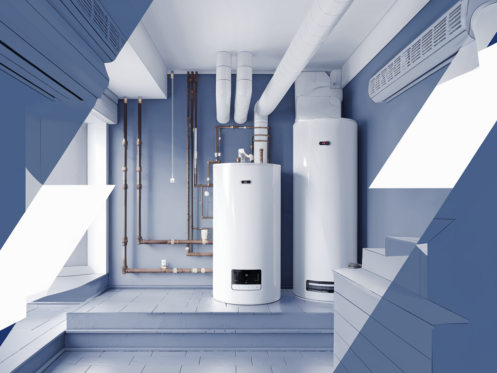Water heater leaks can be a big problem for homeowners, especially when they occur at the bottom of the unit. Fixing a water heater leaking from the bottom quickly is important to avoid potential water damage and increased utility bills. Ignoring this issue can lead to more serious problems, such as structural damage to your home and very high energy costs due to wasting energy.
In this guide, we’ll explore the common causes of water heater leaks from the bottom, offer immediate actions you can take if you notice a leak, and discuss potential fixes. We’ll also cover when it might be time to consider replacing your water heater and how to choose a new one. By knowing these things, you can make smart choices to keep your home safe and your water heater working well.
Common Causes of Water Heater Leaking from Bottom
There are several reasons why your water heater might be leaking from the bottom:
- Sediment Build-up: Over time, minerals from hard water can accumulate at the bottom of the tank, leading to corrosion and leaks.
- Faulty Drain Valve: The drain valve is used for maintenance tasks like flushing the tank. If it’s not sealed properly, it can cause leaks.
- Problems with Pressure Relief Valve: If the pressure relief valve is faulty or improperly installed, it can cause water to leak from the bottom.
- Internal Tank Damage: Corrosion or cracks within the tank itself can lead to leaks, often requiring a full replacement.
To identify the source of the leak, inspect the area around the bottom of the water heater. Look for signs of rust, pooling water, or dripping from the drain valve. Finding out why the leak happens is the first step to fixing it.
Immediate Actions: Hot Water Tank Leaking from Bottom
Discovering a leak at the bottom of your hot water tank can be alarming, but taking swift action is crucial to minimize damage. Here’s a step-by-step guide to help you manage the situation safely:
- Switch Off the Power: For electric water heaters, switch off the power at the circuit breaker. For gas water heaters, turn the gas control valve to the ‘pilot’ setting.
- Shut Off the Water Supply: Locate the cold water shut-off valve, typically found on top of the heater. Turn it clockwise to stop the water flow and prevent further leakage.
- Drain the Tank: Attach a garden hose to the drain valve at the bottom of the tank. Run the hose to a safe drainage area, and open the valve to let the water out. This helps in assessing the extent of the leak.
- Inspect for Damage: Once drained, carefully inspect the bottom of the tank for visible cracks or corrosion. This will help determine whether a repair or replacement is necessary.
- Contact a Professional: If you’re unsure about the next steps or if the damage seems extensive, it’s best to contact a professional plumber for a thorough assessment and repair.
Fixing a Water Heater Tank Leaking from Bottom
Once you’ve managed the immediate situation, the next step is to address the cause of the leak. Here are some potential fixes for a water heater tank leaking from the bottom:
- Replace the Drain Valve: A faulty drain valve is a common cause of leaks. If water is leaking from the valve, it may need to be replaced. You can purchase a new valve from a hardware store and install it yourself if you’re comfortable with DIY repairs.
- Flush Out Sediment: Over time, sediment can accumulate at the bottom of the tank, leading to corrosion and leaks. Regularly flushing the tank helps remove this buildup and can extend the life of your water heater. For detailed maintenance tips, check out this guide from Althoff Industries Inc. or visit our Water Heater Maintenance Guide.
- Check for Corrosion: If the tank itself is corroded, repairs might not be feasible. Corrosion usually means the water heater is getting old.
If the water heater is significantly damaged or old, replacement might be the best option. For guidance on when to replace a water heater, visit The Home Depot’s guide or our Water Heater Replacement Cost Tips.
Replacement Considerations: Bottom of Hot Water Heater Leaking
When it comes to a water heater leaking from the bottom, sometimes repairs just aren’t enough. Here are some signs that it might be time to consider replacing your water heater:
- Heater’s Age: Most water heaters last about 8 to 12 years. If yours is within this range or older, replacement might be more cost-effective than constant repairs.
- Frequent Repairs: If you find yourself repeatedly fixing leaks or other issues, it could be a signal that your heater is nearing the end of its useful life.
- Rusty Water: Rusty water coming from your hot water tap can indicate corrosion inside the tank, which is a strong sign that replacement is needed.
- Lower Efficiency: If your heater is not heating water as efficiently as it used to, it might be time to upgrade to a more energy-efficient model.
For more detailed guidance on when to replace a water heater, check out this resource from The Home Depot.
Choosing a New Water Heater
When selecting a new water heater, there are several factors to consider to ensure you pick the best option for your home:
- Energy Efficiency: Look for models with high energy efficiency ratings to save on utility bills and reduce your carbon footprint.
- Water Heater Type: Decide between tankless or traditional tank models. Tankless heaters provide hot water on demand and take up less space, while traditional tanks store and heat a large volume of water.
- Size: Choose a size that fits your household’s hot water needs. Consider the number of people in your home and your water usage habits.
- Fuel Source: Decide if you want an electric, gas, or solar heater based on what’s available and costs in your area.
For more information on selecting an energy-efficient water heater, visit the Department of Energy’s guide.
Conclusion and Next Steps
Fixing a water heater leaking from the bottom is important to prevent further damage to your home and avoid increased utility bills. Here’s a quick recap of what we’ve covered:
- Understanding the common causes of leaks can help you diagnose the issue early.
- Acting quickly, like switching off the power and water, is important for safety.
- Repair options include replacing faulty parts or flushing out sediment.
- Consider replacing your water heater if repairs are insufficient.
- Choosing an energy-efficient model can save you money in the long run.
If you’re experiencing issues with your water heater or need professional assistance, don’t hesitate to reach out to Quality Cooling and Heating. Our team offers expert plumbing and HVAC services to keep your home comfortable and safe. With our community-focused approach, you can trust us to handle your needs with care and expertise. For more information on our services, visit our Services Page.


